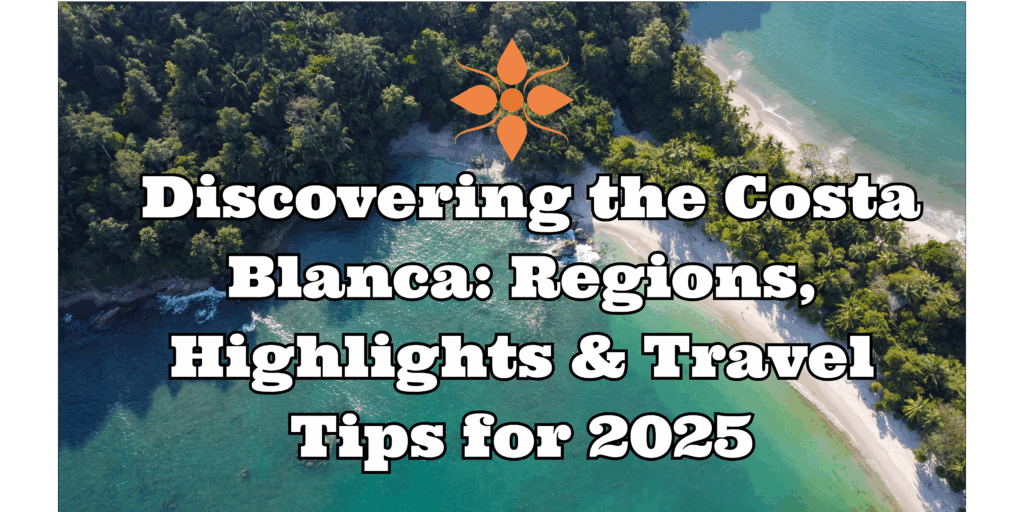
🏖️ Discovering the Costa Blanca: Regions, Highlights & Travel Tips for 2025
The Costa Blanca — or “White Coast” — is one of Spain’s most beloved and sun-drenched regions. From historic villages to turquoise coves, this Mediterranean gem offers something for every type of traveler. Whether you’re visiting for the first time or dreaming of a longer stay, this in-depth guide covers everything you need to know about the Costa Blanca in 2025.
📍 Where Is the Costa Blanca?
The Costa Blanca is located in the province of Alicante, in the southeastern part of Spain. This coastline stretches over 200 kilometers, from the town of Dénia in the north to Pilar de la Horadada in the south. It borders the Costa del Azahar to the north and the Costa Cálida to the south.
It’s known for:
-
- Mild Mediterranean climate
-
- Endless beaches and rocky coves
-
- Whitewashed villages and historic towns
-
- Outdoor adventure and authentic Spanish culture
📌 Fact: Costa Blanca got its name from British Airways in the 1950s to promote this sunny coastline.
🧭 Exploring the Main Regions of Costa Blanca
To better understand and plan your trip, it helps to divide Costa Blanca into three main zones:
🌿 Northern Costa Blanca
Towns: Dénia, Jávea (Xàbia), Moraira, Calpe, Benissa
This area is more mountainous and greener than the rest of the coast. Here, you’ll find:
-
- Dramatic cliffs and hidden coves
-
- Traditional villages with a local feel
-
- Charming marinas, perfect for sailing enthusiasts
-
- Montgó Natural Park for hiking and panoramic views
🔍 Don’t Miss: The crystal-clear waters of Cala del Moraig and the blue-domed church in Altea (just south of this zone).
🏖️ Central Costa Blanca
Towns: Altea, Benidorm, Villajoyosa, Alfaz del Pi
The heart of Costa Blanca mixes historic beauty with modern entertainment:
-
- Benidorm: A skyscraper-filled beach city with nightlife, casinos, and theme parks
-
- Altea: A picture-perfect town with cobblestone streets and art galleries
-
- Villajoyosa: Known for its colorful houses and chocolate-making history
🎨 Pro Tip: Visit Altea’s old town at sunset for breathtaking views over the sea and Serra Gelada mountains.
🌅 Southern Costa Blanca
Towns: Alicante, Torrevieja, Guardamar del Segura, Orihuela Costa
This area is flatter and more urbanized, with longer beaches and lively resort towns. It’s perfect for:
-
- Beach holidays with easy access
-
- Golf trips, thanks to top-notch golf resorts
-
- Affordable stays for long-term travelers or digital nomads
🏝️ Hotspot: The salt lakes of Torrevieja — pink in summer — are a unique natural attraction and perfect for wellness tourism.
🌤️ When Is the Best Time to Visit the Costa Blanca?
The Costa Blanca boasts one of Europe’s most stable climates, averaging 320 days of sunshine per year. Here’s a quick seasonal breakdown:
| Season | Weather | Best For |
|---|---|---|
| Spring (Mar–May) | 18–24°C | Outdoor exploring, hiking, fewer tourists |
| Summer (Jun–Aug) | 28–35°C | Beach time, nightlife, water sports |
| Autumn (Sep–Nov) | 20–28°C | Warm sea, festivals, fewer crowds |
| Winter (Dec–Feb) | 12–18°C | Mild weather, perfect for retirees or long stays |
💡 Bonus: Costa Blanca is a year-round cycling and hiking destination, especially in the north.
🚍 How to Get to Costa Blanca
The region is highly accessible, especially from the UK, the Netherlands, Germany, and Nordic countries.
Main transport options:
-
- ✈️ Alicante-Elche Airport (ALC): Just 15 minutes from Alicante city
-
- ✈️ Valencia Airport (VLC): Ideal for northern destinations like Dénia
-
- 🚄 Train: High-speed trains connect Alicante with Madrid, Valencia & Barcelona
-
- 🚗 Car rental: Best option for exploring smaller villages and nature parks
-
- 🚌 Buses: ALSA operates budget-friendly intercity buses
🚆 Insider tip: The scenic tram line (TRAM Metropolitano) runs from Alicante to Dénia, passing through beautiful coastal towns.
👨👩👧 Best Traveler Types for Costa Blanca
This isn’t just a party coast. The Costa Blanca suits nearly every lifestyle and budget:
👪 Families:
-
- Safe, shallow beaches
-
- Theme parks like Terra Mítica and Aqualandia
-
- Child-friendly resorts
👩💻 Digital Nomads:
-
- Great Wi-Fi, coworking spaces in Alicante & Jávea
-
- Affordable long-term rentals
-
- English-speaking communities
🧓 Retirees:
-
- Excellent healthcare
-
- Warm winters
-
- Strong expat networks, especially in Torrevieja and Orihuela Costa
🌄 Adventurers:
-
- Mountain hiking in Sierra Bernia and Montgó
-
- Snorkeling in clear coves near Benissa
-
- Kayaking, paragliding, and rock climbing
🌇 Must-Visit Towns on the Costa Blanca
Each town along this coast has a different flavor. Some are luxurious and quiet, others buzzing and modern.
Top Picks:
-
- 🖼️ Altea: Whitewashed houses, artsy vibes, and a charming old town
-
- 🎢 Benidorm: High energy, iconic skyline, live shows, beaches
-
- 🧭 Dénia: A castle overlooking the sea, ferry to Ibiza, great food scene
-
- 🐚 Jávea: Hidden coves, seafood restaurants, ideal for nature lovers
-
- 🎣 Villajoyosa: Historic fishing town, bright-colored houses, chocolate factory tours
-
- 🏖️ Torrevieja: Bustling city with promenades, nightlife, and international community
🍽️ What’s the Food Like?
Costa Blanca cuisine blends Valencian, Mediterranean, and seafood traditions. Must-tries include:
-
- 🥘 Arroz a banda: Rice cooked in fish stock, a local favorite
-
- 🦑 Calamares a la plancha: Grilled squid, simple and fresh
-
- 🧄 Alioli: Garlic mayo served with bread or potatoes
Pair your meals with local wines from Alicante and enjoy market-fresh ingredients in towns like Altea and Dénia.
💸 Costs & Budget Tips
Spain is more affordable than many European destinations — and Costa Blanca is even more so.
| Expense | Average Cost |
|---|---|
| Coffee | €1.50 |
| Tapas dish | €2–€4 |
| Mid-range meal | €12–€20 |
| Budget hotel | €50–€80 per night |
| Long-term rentals | From €600/month |
💰 Tip: Visit in spring or autumn for better hotel deals and milder weather.
🛡️ Is Costa Blanca Safe?
Yes, Costa Blanca is considered very safe for tourists, including solo travelers and families. Petty theft is rare outside the busiest summer months.
🧳 Pro Tip: Avoid leaving valuables on the beach unattended — especially in busier spots like Benidorm.
🗣️ Do They Speak English?
While Spanish is the main language, English is widely spoken in most tourist towns. You’ll also hear Valencian, a regional dialect similar to Catalan.
🏫 Want to blend in? Learn a few local phrases:
-
- Gracias – Thank you
-
- ¿Dónde está la playa? – Where is the beach?
-
- Una cerveza, por favor – A beer, please
🗺️ Interactive Map of Costa Blanca: Towns, Beaches & Must-See Spots
Planning your Costa Blanca adventure? Use the interactive map below to explore the region’s most beautiful towns, coastal attractions, nature reserves, and hidden gems. Whether you’re heading to the charming streets of Altea or the cliffs of Calpe, this map is your perfect travel companion.
🧭 Final Word: Why You Should Visit the Costa Blanca
Whether you’re seeking golden sands, charming mountain towns, or year-round sunshine, the Costa Blanca delivers on all fronts. With its excellent infrastructure, laid-back lifestyle, and mix of old and new, it’s easy to see why this region has become a favorite for both travelers and expats alike.
